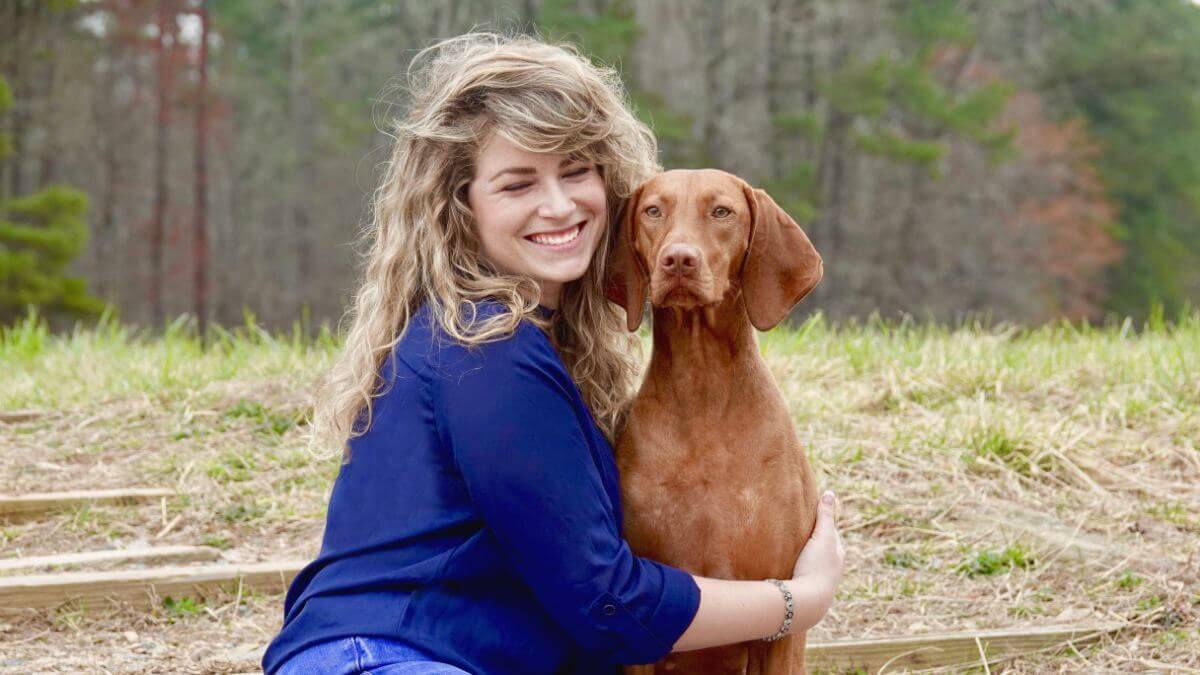
Home » Michelle Porfido-DeLucia | Rhapsody Vizslas

1. I live outside of Raleigh, North Carolina, in Fuquay-Varina. I’ve been in dogs for 27 years (starting in performance events at the age of 9), and have been breeding Vizslas under the “Rhapsody” prefix for 16 years.
2. I don’t evaluate my puppies on their structure until they’re 8 weeks, but I’m always watching them from 6-8 weeks to see who catches my eye, who always stops four-square, and I look for overall balance. At 8 weeks, aside from stacking them, I take all their collars off and watch them move outside in the yard and keep note of who my eye keeps going to. My performance puppies are usually the most balanced/most moderately built, have a high aptitude for learning, and are bold and confident. Of course, sometimes there’s a puppy that encompasses all these traits AND is the pick of the litter in its conformation (and more times than not, is the naughtiest puppy of the litter… and that’s the one I end up keeping).
3. I think, overall, yes, we’re in good shape. There are things that are very difficult to improve and are perpetual issues for the breed, such as inadequate front assemblies, short upper arms, lacking return of upper arm, steep shoulders, and lack of chest fill. I also think breeders really need to pay more attention to maintaining a strong second thigh in their rears, and sufficient length of ribbing. These are Sporting dogs, bred to hunt tirelessly, so form must follow function.
4. That’s a loaded question… I think the judges can only do as well as the entry of dogs they’re given. Of course, there are some judges that you can easily follow and understand what they like, and then there are ones you shake your head at and go, “I have no idea what I just watched.” It’s always going to be that way, and the only thing we can do as breeders/exhibitors is try to educate them and ask questions respectfully. Judges are evaluating their entries off of their interpretation of the Breed Standard, so to some extent, you just have to be able to follow what they like so that you know what to bring them. There are a ton of shows, which I can find an argument for and against. On the one hand, there are more opportunities for majors and different options for circuits. Alternatively, all the options lead to scattered entry numbers, with little to no dependable entry trends. I think there is something to say for large circuits that offer special attractions, in lieu of several scattered small shows. For example, a large four-day circuit that offers Best Bred-By in Show, Best Owner-Handled in Show, monetary awards, big prizes and raffles, affordable vendor space (opportunity for more vendors), Junior Handler showcases, etc., will almost always draw a dependable attendance because there’s something for everyone. I DO think the fact that judges are not paid for special attraction assignments is something that needs to be amended.
Judges are evaluating their entries off of their interpretation of the Breed Standard, so to some extent, you just have to be able to follow what they like so that you know what to bring them.
5. It’s unrealistic to think that social media’s role in the sport is going to change. People love to complain behind the comfort of their keyboard, whether it be anonymously in a forum, or in a public Facebook group that has judges as members. So, is it good? Harmful? It’s both. It’s as useful and as harmful as people make it. I think the majority of people use Facebook as free marketing/advertising for their dogs, which there’s absolutely nothing wrong with, and to try and keep tabs on building majors at specific circuits.
6. Unequivocally, the lack of teamwork and camaraderie is the biggest challenge. I can’t tell you how painful it is to build entries in low-entry breeds. We try to make groups on Facebook to build entries, but those aren’t always successful. People complain about “super clusters” and way too many shows being available in comparison to how it was, say, 10 years ago. More show opportunities on the same weekends (clusters competing for entries) disperses entries instead of forcing people to enter the only show in the area.
7. The development of the Canine College has been an excellent concept and teaching tool.